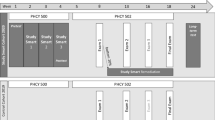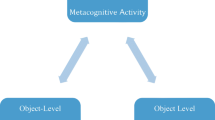ABSTRACT
Current initiatives in science education in Korea have emphasized science literacy as the most important purpose of science education; that is, science education needs to focus on helping each student to become a scientifically literate person who is able to make reasoned decisions. In attempting to address this focus concern about science literacy, the researchers of this study attempted to implement the Science Writing Heuristic (SWH) approach and examined both the SWH and the control groups using the modified Reformed Teaching Observation Protocol (RTOP). Students’ performance on a Summary Writing Test (SWT) was also examined. Participant students of this study were eighth grade students in three middle schools located in the second biggest city in Korea. Each of the three teachers from three schools taught both the SWH and the control classes. The results of this study showed significant differences between the SWH and the control groups on the SWT. There was a difference in the total RTOP scores between the SWH and the control groups. Differences among schools imply that higher level of teachers’ implementation of the SWH approach would appear to result in better student achievement.
Similar content being viewed by others
References
Akkus, R., Gunel, M. & Hand, B. (2007). Comparing an inquiry-based approach known as the Science Writing Heuristic to traditional science teaching practices: Are there differences? International Journal of Science Education, 1, 1–21.
Bereiter, C. & Scardamalia, M. (1987). The psychology of written composition. Hillsdale: Lawrence Erlbaum.
Britton, J. (1970). Language and learning. New York: Penguin.
Britton, J., Burgess, T., Martin, N., McLeod, A. & Rosen, H. (1975). The development of writing abilities (11–18). London: Macmillan.
Connally, P. (1989). Writing and the ecology of learning. In P. Connally & T. Vilardi (Eds.), Writing to learn mathematics and science (pp. 1–14). New York: Teachers College Press.
Driver, R., Newton, P. & Osborne, J. (2000). Establishing the norms of scientific argumentation in classrooms. Science & Education, 84(3), 287–312.
Emig, J. (1977). Writing as a mode of learning. College Composition and Communication, 28, 122–128.
Fellows, N. J. (1994). A window into thinking: Using student writing to understand conceptual change in science learning. Journal of Research in Science Teaching, 31, 985–1001.
Flower, L. & Hayes, J. (1980). The cognition of discovery: Defining a rhetorical problem. College Composition and Communication, 31, 21–32.
Galbraith, D. (1999). Writing as a knowledge-constituting process. In D. Galbraith & M. Torrance (Eds.), Knowing what to write: Conceptual processes in text production (pp. 139–159). Amsterdam: Amsterdam University Press.
Greenbowe, T. J. & Hand, B. (2005). Using the science writing heuristic to improve students’ understanding of chemistry. In N. J. Pienta, M. M. Cooper, & T. J. Greenbowe (Eds.), Chemists guide to effective teaching. Upper Saddle River, NJ: Prentice Hall.
Gunel, M., Hand, B. & McDermott, M. (2009). Writing for different audiences: Effects on high school students’ conceptual understanding of biology. Learning and Instruction, 19, 354–367.
Hand, B. (2004). Cognitive, constructivist mechanisms for learning science through writing. In C. S. Wallace, B. Hnad & V. Prain (Eds.), Writing and learning in the science classroom (pp. 21–31). Dordrecht, The Netherlands: Kluwer Academic Press.
Hand, B., Hohenshell, L. & Prain, V. (2004). Exploring students’ responses to conceptual questions when engaged with planned writing experiences: A study with Year 10 science students. Journal of Research in Science Teaching, 41(2), 186–210.
Hand, B., Hohenshell, L. & Prain, V. (2007). Examining the effect of multiple writing tasks on Year 10 biology students’ understandings of cell and molecular biology concepts. Instructional Science, 35, 343–373.
Hand, B. & Keys, C. W. (1999). Inquiry investigation: A new approach to laboratory reports. The Science Teacher, 66(4), 27–29.
Hand, B., Norton-Meier, L., Staker, J. & Bintz, J. (2009). Negotiating science: The critical role of argument in student inquiry. Portsmouth, NH: Heinemann.
Herrenkohl, L. R. & Guerra, M. R. (1998). Participant structures, scientific discourse, and student engagement in fourth grade. Cognition and Instruction, 16(4), 431–473.
Hohenshell, L. M. & Hand, B. (2006). Writing-to-learn strategies in secondary school cell biology: A mixed method study. International Journal of Science Education, 28(2–3), 261–289.
Jimenez-Aleixandre, M. P., Bugallo-Rodriguez, A. & Duschl, R. A. (2000). “Doing the lesson” or “doing science”: Argument in high school genetics. Science Education, 84, 757–792.
Keys, C. W., Hand, B., Prain, V. & Collins, S. (1999). Using the Science Writing Huerisitic as a tool for learning from laboratory investigations in secondary science. Journal of Research in Science Teaching, 36(10), 1065–1084.
Korea Institute for Curriculum and Evaluation (2008). Korean students’ achievement in TIMS International Science Report. Seoul: Koran Institute for Curriculum and Evaluation.
Korea Ministry of Education (2007). Korea National Science Education Standards. Seoul, Korea: Korea Ministry of Education.
Kuhn, D. (1991). The skills of argument. Cambridge, UK: Cambridge University Press.
Kuhn, D. (1993). Science as argument: Implications for teaching and learning scientific thinking. Science Education, 77, 319–337.
Langer, J. A. & Applebee, A. N. (1987). How writing shapes thinking: A study of teaching and learning (NCTE research report. No. 22). Urbana, IL: National Council of Teachers of English.
Lee, B. (1998). Argumentation and Secondary Science Education. Research report (RR 97-II-6). Seoul: Korea Research Foundation.
Martin, A. & Hand, B. (2009). Factors affecting the implementation of argument in the Elementary Science Classroom. A longitudinal case study. Research in Science Education, 39(1), 17–38.
Martin, M. O., Mullis, I. V. S. & Foy, P. (2008). TIMSS 2007 International Science Report: Findings from IEA's trends in International Mathematics and Science Study at the fourth and eighth grade. MA: Boston College.
Mason, L. & Boscolo, P. (2000). Writing and conceptual change: What changes? Instructional Science, 28, 199–226.
Millar, R. & Osborne, J. (1998). Beyond 2000: Science education for the future. London: King’s College.
National Research Council (1996). National science education standards. Washington, DC: National Academy Press.
Newton, P., Driver, R. & Osborne, J. (1999). The place of argumentation in the pedagogy of school science. International Journal of Science Education, 21(5), 553–576.
Osborne, J., Erduran, S. & Simon, S. (2004). Enhancing the quality of argumentation in school science. Journal of Research in Science Teaching, 41(10), 994–1020.
Rivard, L. P. (1994). A review of writing to learn in science: Implication for practice and research. Journal of Research in Science Teaching, 31, 969–983.
Rivard, L. P. & Straw, S. W. (2000). The effect of talk and writing on learning science: An exploratory study. Science & Education, 84, 566–593.
Rudd, J. A., Greenbowe, T. J. & Hand, B. M. (2001). Recrafting the general chemistry laboratory report. Journal of College Science Teaching, 31(4), 230–234.
Rudd, J. A., Greenbowe, T. J., Hand, B. M. & Legg, M. J. (2001). Using the Science Writing Heuristic (SWH) to move toward an inquiry-based laboratory curriculum: An example from physical equilibrium. Journal of Chemical Education, 78(12), 1680–1686.
Sampson, V. & Clark, D. (2009). The impact of collaboration on the outcomes of scientific argumentation. Science & Education, 93(3), 448–484.
Author information
Authors and Affiliations
Corresponding author
Rights and permissions
About this article
Cite this article
Nam, J., Choi, A. & Hand, B. IMPLEMENTATION OF THE SCIENCE WRITING HEURISTIC (SWH) APPROACH IN 8TH GRADE SCIENCE CLASSROOMS. Int J of Sci and Math Educ 9, 1111–1133 (2011). https://doi.org/10.1007/s10763-010-9250-3
Received:
Accepted:
Published:
Issue Date:
DOI: https://doi.org/10.1007/s10763-010-9250-3




